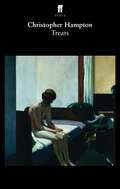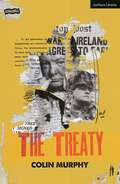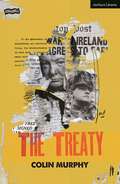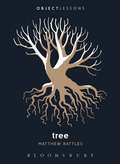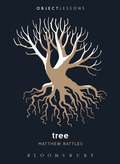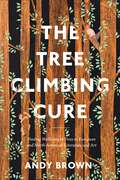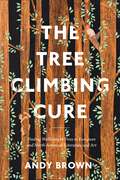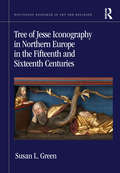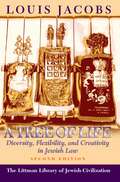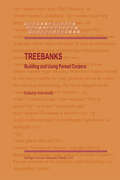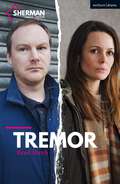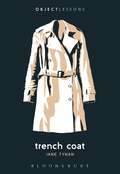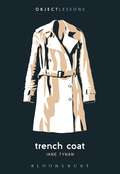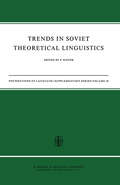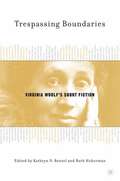- Table View
- List View
Treats: Treats
by Christopher HamptonWhile her bullying and unfaithful boyfriend, Dave, is reporting in Iraq, Ann seizes the opportunity to change the locks and take up with her infinitely more considerate colleague Patrick. But Patrick proves no match against savagery and charisma when Dave comes crashing home, determined to win back his girl.First staged at the Royal Court Theatre, London, in 1976, this updated version demonstrates that, in love, our instinct for making the wrong decisions remains as sharp as ever. Treats was revived at the Garrick Theatre, London, in February 2007, following a tour to Windsor, Malvern, Bath and Richmond.
The Treaty (Modern Plays)
by Colin MurphyIn October 1921, a delegation of the Dáil left by boat and train for London, where they were to negotiate with the British government for peace, unity and a republic. They came back with just one of those; and that peace didn't last long, as war with Britain was replaced by war with their own. Were the Irish outclassed or outgunned? Were they lied to? Did they lie to their own colleagues back in Dublin? Or did they achieve the best that could be achieved, an incremental step on the way to fuller sovereignty? The Treaty tells the story of what happened inside those negotiations, as Arthur Griffith, Michael Collins and colleagues faced off against one of the most formidable negotiating teams ever assembled, headed by David Lloyd George and with Winston Churchill often at his side. This edition is published to coincide with Fishamble's production in November 2021.
The Treaty (Modern Plays)
by Colin MurphyIn October 1921, a delegation of the Dáil left by boat and train for London, where they were to negotiate with the British government for peace, unity and a republic. They came back with just one of those; and that peace didn't last long, as war with Britain was replaced by war with their own. Were the Irish outclassed or outgunned? Were they lied to? Did they lie to their own colleagues back in Dublin? Or did they achieve the best that could be achieved, an incremental step on the way to fuller sovereignty? The Treaty tells the story of what happened inside those negotiations, as Arthur Griffith, Michael Collins and colleagues faced off against one of the most formidable negotiating teams ever assembled, headed by David Lloyd George and with Winston Churchill often at his side. This edition is published to coincide with Fishamble's production in November 2021.
Tree (Object Lessons)
by Matthew BattlesObject Lessons is a series of short, beautifully designed books about the hidden lives of ordinary things. Tree explores the forms, uses, and alliances of this living object's entanglement with humanity, from antiquity to the present. Trees tower over us and yet fade into background. Their lifespan outstrips ours, and yet their wisdom remains inscrutable, treasured up in the heartwood. They serve us in many ways-as keel, lodgepole, and execution site-and yet to become human, we had to come down from their limbs. In this book Matthew Battles follows the tree's branches across art, poetry, and landscape, marking the edges of imagination with wildness and shadow. Object Lessons is published in partnership with an essay series in the The Atlantic.
Tree (Object Lessons)
by Matthew BattlesObject Lessons is a series of short, beautifully designed books about the hidden lives of ordinary things. Tree explores the forms, uses, and alliances of this living object's entanglement with humanity, from antiquity to the present. Trees tower over us and yet fade into background. Their lifespan outstrips ours, and yet their wisdom remains inscrutable, treasured up in the heartwood. They serve us in many ways-as keel, lodgepole, and execution site-and yet to become human, we had to come down from their limbs. In this book Matthew Battles follows the tree's branches across art, poetry, and landscape, marking the edges of imagination with wildness and shadow. Object Lessons is published in partnership with an essay series in the The Atlantic.
The Tree Climbing Cure: Finding Wellbeing in Trees in European and North American Literature and Art (Environmental Cultures)
by Andy BrownOur relationship with trees is a lengthy, complex one. Since we first walked the earth we have, at various times, worshiped them, felled them and even talked to them. For many of us, though, our first memories of interacting with trees will be of climbing them.Exploring how tree climbers have been represented in literature and art in Europe and North America over the ages, The Tree Climbing Cure unpacks the curative value of tree climbing, examining when and why tree climbers climb, and what tree climbing can do for (and say about) the climber's mental health and wellbeing.Bringing together research into poetry, novels, and paintings with the science of wellbeing and mental health and engaging with myth, folklore, psychology and storytelling, Tree Climber also examines the close relationship between tree climbing and imagination, and questions some longstanding, problematic gendered injunctions about women climbing trees. Discussing, among others, the literary works of Margaret Atwood; Charlotte Bronte; Geoffrey Chaucer; Angela Carter; Kiran Desai; and J.R.R. Tolkien, as well as work by artists such as Peter Doig; Paula Rego; and Goya, this book stands out as an almost encyclopedic examination of cultural representations of this quirky and ultimately restorative pastime.
The Tree Climbing Cure: Finding Wellbeing in Trees in European and North American Literature and Art (Environmental Cultures)
by Andy BrownOur relationship with trees is a lengthy, complex one. Since we first walked the earth we have, at various times, worshiped them, felled them and even talked to them. For many of us, though, our first memories of interacting with trees will be of climbing them.Exploring how tree climbers have been represented in literature and art in Europe and North America over the ages, The Tree Climbing Cure unpacks the curative value of tree climbing, examining when and why tree climbers climb, and what tree climbing can do for (and say about) the climber's mental health and wellbeing.Bringing together research into poetry, novels, and paintings with the science of wellbeing and mental health and engaging with myth, folklore, psychology and storytelling, Tree Climber also examines the close relationship between tree climbing and imagination, and questions some longstanding, problematic gendered injunctions about women climbing trees. Discussing, among others, the literary works of Margaret Atwood; Charlotte Bronte; Geoffrey Chaucer; Angela Carter; Kiran Desai; and J.R.R. Tolkien, as well as work by artists such as Peter Doig; Paula Rego; and Goya, this book stands out as an almost encyclopedic examination of cultural representations of this quirky and ultimately restorative pastime.
Tree of Jesse Iconography in Northern Europe in the Fifteenth and Sixteenth Centuries (Routledge Research in Art and Religion)
by Susan L. GreenThis book is the first detailed investigation to focus on the late medieval use of Tree of Jesse imagery, traditionally a representation of the genealogical tree of Christ. In northern Europe, from the mid-fifteenth to the early sixteenth centuries, it could be found across a wide range of media. Yet, as this book vividly illustrates, it had evolved beyond a simple genealogy into something more complex, which could be modified to satisfy specific religious requirements. It was also able to function on a more temporal level, reflecting not only a clerical preoccupation with a sense of communal identity, but a more general interest in displaying a family’s heritage, continuity and/or social status. It is this dynamic and polyvalent element that makes the subject so fascinating.
Tree of Jesse Iconography in Northern Europe in the Fifteenth and Sixteenth Centuries (Routledge Research in Art and Religion)
by Susan L. GreenThis book is the first detailed investigation to focus on the late medieval use of Tree of Jesse imagery, traditionally a representation of the genealogical tree of Christ. In northern Europe, from the mid-fifteenth to the early sixteenth centuries, it could be found across a wide range of media. Yet, as this book vividly illustrates, it had evolved beyond a simple genealogy into something more complex, which could be modified to satisfy specific religious requirements. It was also able to function on a more temporal level, reflecting not only a clerical preoccupation with a sense of communal identity, but a more general interest in displaying a family’s heritage, continuity and/or social status. It is this dynamic and polyvalent element that makes the subject so fascinating.
A Tree of Life: Diversity, Flexibility and Creativity in Jewish Law [Second Edition] (The Littman Library of Jewish Civilization)
by Louis JacobsThis study of the Jewish legal system (the Halakhah) demonstrates that the law embraces every corner of life.
The Tree of Life and Arboreal Aesthetics in Early Modern Literature (Routledge Studies in World Literatures and the Environment)
by Victoria BladenThe Tree of Life and Arboreal Aesthetics in Early Modern Literature explores the vital motif of the tree of life and what it meant to early modern writers who drew from its long histories in biblical, classical and folkloric contexts, giving rise to a language of trees, an arboreal aesthetics. An ancient symbol of immortality, the tree of life was appropriated by Christian ideology and iconography to express ideas about Christ; however, the concept also migrated beyond religious doctrine. Ideas circulating around the tree of life enabled writers to imagine and articulate ideas of death and rebirth, loss and regeneration, the condition of the political state and personal states of the soul through arboreal metaphors and imagery. The motif could be used to sacralise landscapes, such as the garden, orchard or country estate, blurring the lines between contemporary green spaces and the spiritual and poetic imaginary. Located within the field of environmental humanities, and intersecting with ecocriticism and critical plant studies, this volume outlines a comprehensive history of the tree of life and offers interdisciplinary readings of focus texts by Shakespeare, George Herbert, Henry Vaughan, Aemilia Lanyer, Andrew Marvell and Ralph Austen. It includes consideration of related ideas and motifs, such as the tree of Jesse and the Green Man, illuminating the rich histories and meanings that emerge when an understanding of the tree of life and arboreal aesthetics are brought to the analysis of early modern literary texts and their representations of green spaces, both physical and metaphysical.
The Tree of Life and Arboreal Aesthetics in Early Modern Literature (Routledge Studies in World Literatures and the Environment)
by Victoria BladenThe Tree of Life and Arboreal Aesthetics in Early Modern Literature explores the vital motif of the tree of life and what it meant to early modern writers who drew from its long histories in biblical, classical and folkloric contexts, giving rise to a language of trees, an arboreal aesthetics. An ancient symbol of immortality, the tree of life was appropriated by Christian ideology and iconography to express ideas about Christ; however, the concept also migrated beyond religious doctrine. Ideas circulating around the tree of life enabled writers to imagine and articulate ideas of death and rebirth, loss and regeneration, the condition of the political state and personal states of the soul through arboreal metaphors and imagery. The motif could be used to sacralise landscapes, such as the garden, orchard or country estate, blurring the lines between contemporary green spaces and the spiritual and poetic imaginary. Located within the field of environmental humanities, and intersecting with ecocriticism and critical plant studies, this volume outlines a comprehensive history of the tree of life and offers interdisciplinary readings of focus texts by Shakespeare, George Herbert, Henry Vaughan, Aemilia Lanyer, Andrew Marvell and Ralph Austen. It includes consideration of related ideas and motifs, such as the tree of Jesse and the Green Man, illuminating the rich histories and meanings that emerge when an understanding of the tree of life and arboreal aesthetics are brought to the analysis of early modern literary texts and their representations of green spaces, both physical and metaphysical.
Treebanks: Building and Using Parsed Corpora (Text, Speech and Language Technology #20)
by Anne AbeilléThis book provides a state of the art on work being done with parsed corpora. It gathers 21 papers on building and using parsed corpora raising many relevant questions, and deals with a variety of languages and a variety of corpora. It is for those working in linguistics, computational linguistics, natural language, syntax, and grammar.
Trees in Nineteenth-Century English Fiction: The Silvicultural Novel (Routledge Environmental Humanities)
by Anna BurtonThis is a book about a longstanding network of writers and writings that celebrate the aesthetic, socio-political, scientific, ecological, geographical, and historical value of trees and tree spaces in the landscape; and it is a study of the effect of this tree-writing upon the novel form in the long nineteenth century. Trees in Nineteenth-Century English Fiction: The Silvicultural Novel identifies the picturesque thinker William Gilpin as a significant influence in this literary and environmental tradition. Remarks on Forest Scenery (1791) is formed by Gilpin’s own observations of trees, forests, and his New Forest home specifically; but it is also the product of tree-stories collected from ‘travellers and historians’ that came before him. This study tracks the impact of this accumulating arboreal discourse upon nineteenth-century environmental writers such as John Claudius Loudon, Jacob George Strutt, William Howitt, and Mary Roberts, and its influence on varied dialogues surrounding natural history, agriculture, landscaping, deforestation, and public health. Building upon this concept of an ongoing silvicultural discussion, the monograph examines how novelists in the realist mode engage with this discourse and use their understanding of arboreal space and its cultural worth in order to transform their own fictional environments. Through their novelistic framing of single trees, clumps, forests, ancient woodlands, and man-made plantations, Jane Austen, Elizabeth Gaskell, and Thomas Hardy feature as authors of particular interest. Collectively, in their environmental representations, these novelists engage with a broad range of silvicultural conversation in their writing of space at the beginning, middle, and end of the nineteenth century. This book will be of great interest to students, researchers, and academics working in the environmental humanities, long nineteenth-century literature, nature writing and environmental literature, environmental history, ecocriticism, and literature and science scholarship.
Trees in Nineteenth-Century English Fiction: The Silvicultural Novel (Routledge Environmental Humanities)
by Anna BurtonThis is a book about a longstanding network of writers and writings that celebrate the aesthetic, socio-political, scientific, ecological, geographical, and historical value of trees and tree spaces in the landscape; and it is a study of the effect of this tree-writing upon the novel form in the long nineteenth century. Trees in Nineteenth-Century English Fiction: The Silvicultural Novel identifies the picturesque thinker William Gilpin as a significant influence in this literary and environmental tradition. Remarks on Forest Scenery (1791) is formed by Gilpin’s own observations of trees, forests, and his New Forest home specifically; but it is also the product of tree-stories collected from ‘travellers and historians’ that came before him. This study tracks the impact of this accumulating arboreal discourse upon nineteenth-century environmental writers such as John Claudius Loudon, Jacob George Strutt, William Howitt, and Mary Roberts, and its influence on varied dialogues surrounding natural history, agriculture, landscaping, deforestation, and public health. Building upon this concept of an ongoing silvicultural discussion, the monograph examines how novelists in the realist mode engage with this discourse and use their understanding of arboreal space and its cultural worth in order to transform their own fictional environments. Through their novelistic framing of single trees, clumps, forests, ancient woodlands, and man-made plantations, Jane Austen, Elizabeth Gaskell, and Thomas Hardy feature as authors of particular interest. Collectively, in their environmental representations, these novelists engage with a broad range of silvicultural conversation in their writing of space at the beginning, middle, and end of the nineteenth century. This book will be of great interest to students, researchers, and academics working in the environmental humanities, long nineteenth-century literature, nature writing and environmental literature, environmental history, ecocriticism, and literature and science scholarship.
A Tremendous Thing: Friendship from the "Iliad" to the Internet
by Gregory Jusdanis"Why did you do all this for me?" Wilbur asked. "I don't deserve it. I've never done anything for you.""You have been my friend," replied Charlotte. "That in itself is a tremendous thing."—from Charlotte’s Web by E. B. White Friendship encompasses a wide range of social bonds, from playground companionship and wartime camaraderie to modern marriages and Facebook links. For many, friendship is more meaningful than familial ties. And yet it is our least codified relationship, with no legal standing or bureaucratic definition. In A Tremendous Thing, Gregory Jusdanis explores the complex, sometimes contradictory nature of friendship, reclaiming its importance in both society and the humanities today. Ranging widely in his discussion, he looks at the art of friendship and friendship in art, finding a compelling link between our need for friends and our engagement with fiction. Both, he contends, necessitate the possibility of entering invented worlds, of reading the minds of others, and of learning to live with people. Investigating the ethics, aesthetics, and politics of friendship, Jusdanis draws from the earliest writings to the present, from the Epic of Gilgamesh and the Iliad to Charlotte’s Web and "Brokeback Mountain," as well as from philosophy, sociology, evolutionary biology, psychology, and political theory. He asks: What makes friends stay together? Why do we associate friendship with mourning? Does friendship contribute to the formation of political communities? Can friends desire each other? The history of friendship demonstrates that human beings are a mutually supportive species with an innate aptitude to envision and create ties with others. At a time when we are confronted by war, economic inequality, and climate change, Jusdanis suggests that we reclaim friendship to harness our capacity for cooperation and empathy.
Tremor (Modern Plays)
by Brad BirchThis is the person I am now. It's the person I want to be, should have been for a long time. We got dark, Sophie. Things got dark, and I...I'm better now. I'm in a better place...Once our lives are touched by tragedy, can we ever truly move on? Sophie and Tom's relationship fell apart in the aftermath of a catastrophe. Four years on, as they come face to face once again, the aftershocks of that fateful day can still be felt.Tremor is a play about now. It's about how we choose to see things and live our lives in a world riven with tension, anxiety and division. This thrilling new play by Brad Birch, recipient of the Harold Pinter Commission, offers a taut, intense and thrilling two-hander.
Tremor (Modern Plays)
by Brad BirchThis is the person I am now. It's the person I want to be, should have been for a long time. We got dark, Sophie. Things got dark, and I...I'm better now. I'm in a better place...Once our lives are touched by tragedy, can we ever truly move on? Sophie and Tom's relationship fell apart in the aftermath of a catastrophe. Four years on, as they come face to face once again, the aftershocks of that fateful day can still be felt.Tremor is a play about now. It's about how we choose to see things and live our lives in a world riven with tension, anxiety and division. This thrilling new play by Brad Birch, recipient of the Harold Pinter Commission, offers a taut, intense and thrilling two-hander.
Trench Coat (Object Lessons)
by Jane TynanObject Lessons is a series of short, beautifully designed books about the hidden lives of ordinary things.We think we know the trench coat, but where does it come from and where will it take us? From its origins in the trenches of WW1, this military outerwear came to project the inner-being of detectives, writers, reporters, rebels, artists and intellectuals. The coat outfitted imaginative leaps into the unknown. Trench Coat tells the story of seductive entanglements with technology, time, law, politics, trust and trespass. Readers follow the rise of a sartorial archetype through media, design, literature, cinema and fashion. Today, as a staple in stories of future life-worlds, the trench coat warns of disturbances to come.Object Lessons is published in partnership with an essay series in The Atlantic.
Trench Coat (Object Lessons)
by Jane TynanObject Lessons is a series of short, beautifully designed books about the hidden lives of ordinary things.We think we know the trench coat, but where does it come from and where will it take us? From its origins in the trenches of WW1, this military outerwear came to project the inner-being of detectives, writers, reporters, rebels, artists and intellectuals. The coat outfitted imaginative leaps into the unknown. Trench Coat tells the story of seductive entanglements with technology, time, law, politics, trust and trespass. Readers follow the rise of a sartorial archetype through media, design, literature, cinema and fashion. Today, as a staple in stories of future life-worlds, the trench coat warns of disturbances to come.Object Lessons is published in partnership with an essay series in The Atlantic.
Trends And Tropes: Some Aspects of African Indigenous Literatures of South Africa
by E.D.M. Sibiya Zilibele MtumaneThis collection explores topical and current issues in indigenous African language literature of South Africa. These include narratological elements of literature, language usage, poetry analysis, and song lyrics. Each scholar presents findings that are particular to their research, thus making the book a valuable source of knowledge penned in a diversity of writing styles across different literary genres.Seventy per cent of the chapters are written in English and thirty per cent in isiZulu, a gesture towards encouraging research presentations in indigenous languages. Also of interest is that the chapter content covers traditional or largely obsolete forms such as folklore and essays.Print edition not for sale in Sub Saharan Africa.
Trends And Tropes: Some Aspects of African Indigenous Literatures of South Africa
This collection explores topical and current issues in indigenous African language literature of South Africa. These include narratological elements of literature, language usage, poetry analysis, and song lyrics. Each scholar presents findings that are particular to their research, thus making the book a valuable source of knowledge penned in a diversity of writing styles across different literary genres.Seventy per cent of the chapters are written in English and thirty per cent in isiZulu, a gesture towards encouraging research presentations in indigenous languages. Also of interest is that the chapter content covers traditional or largely obsolete forms such as folklore and essays.Print edition not for sale in Sub Saharan Africa.
Trends in Parsing Technology: Dependency Parsing, Domain Adaptation, and Deep Parsing (Text, Speech and Language Technology #43)
by Harry Bunt Paola Merlo Joakim NivreComputer parsing technology, which breaks down complex linguistic structures into their constituent parts, is a key research area in the automatic processing of human language. This volume is a collection of contributions from leading researchers in the field of natural language processing technology, each of whom detail their recent work which includes new techniques as well as results. The book presents an overview of the state of the art in current research into parsing technologies, focusing on three important themes: dependency parsing, domain adaptation, and deep parsing. The technology, which has a variety of practical uses, is especially concerned with the methods, tools and software that can be used to parse automatically. Applications include extracting information from free text or speech, question answering, speech recognition and comprehension, recommender systems, machine translation, and automatic summarization. New developments in the area of parsing technology are thus widely applicable, and researchers and professionals from a number of fields will find the material here required reading. As well as the other four volumes on parsing technology in this series this book has a breadth of coverage that makes it suitable both as an overview of the field for graduate students, and as a reference for established researchers in computational linguistics, artificial intelligence, computer science, language engineering, information science, and cognitive science. It will also be of interest to designers, developers, and advanced users of natural language processing systems, including applications such as spoken dialogue, text mining, multimodal human-computer interaction, and semantic web technology.
Trends in Soviet Theoretical Linguistics (Foundations of Language Supplementary Series #18)
by F. Kiefero. Theoretical linguistics is a term not very often used in Soviet Linguistics. The terms 'structural linguistics', 'mathematical linguistics', 'applied lin guistics' (which, incidentally, has another meaning here than in other parts of the world) all may cover theoretical work in linguistics. In older days serious theoretical work was done under the heading 'machine translation'. Very often the need for a special term for theoretically oriented studies in linguistics does not even arise. Does this mean that there is no real theoretical linguistics in the Soviet Union? This would be, of course, a completely false conclusion. Some lin guists tend to identify theoretical linguistics with generative grammar. Though it might be true - and I am myself very much inclined to subscribe to this view - that generative grammar has been the most fruitful linguistic theory up to now, this does not justify, however, the above identification. Incidentally, as we shall see later on, generative grammar has not been left unnoticed in the Soviet Union either. There are different trends within theo retical linguistics, one of which is generative grammar. While generative grammar (though one can worry about the content of this notion for many. internal and external reasons) seems to be the mean theoretical trend in the United States and in Western Europe, it represents only one of the main trends in Soviet linguistics.
Trespassing Boundaries: Virginia Woolf's Short Fiction
by K. Benzel R. HobermanIn Trespassing Boundaries , ten contemporary Woolf scholars discuss a broad range of Woolf's short stories. Despite being now easily available these stories have not yet received the attention they deserve. Complex yet involving, they deserve to be read not only for the light they shed on the novels, but in their own right, as major contributions to the short fiction as a genre. This volume places Woolf's short stories in the context of modernist experimentalism, then explores them as ambitious attempts to challenge generic boundaries, undercutting traditional distinctions between short fiction and the novel, between experimental and popular fiction, between fiction and nonfiction. Collectively the essays suggest that Woolf's contribution to the short story is as important as her contribution to the novel.
